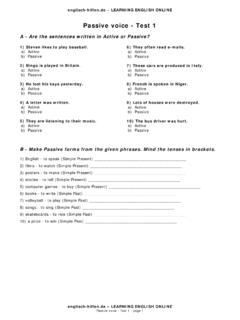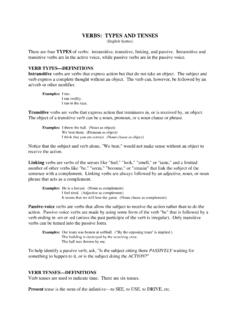Transcription of Hunt the Good Stuff: Practical Exercise (Day 1)
1 Hunt the Good Stuff: Practical Exercise (Day 1) Instructions: In groups of three, record six good things that relate to PCSing in the boxes labeled Good Thing. After each good thing, write a reflection sentence in the corresponding box labeled Reflection using the reflection questions on the slide. Good Thing 1: Reflection: Good Thing 2: Reflection: Good Thing 3: Reflection: Good Thing 4: Reflection: Good Thing 5: Reflection: Good Thing 6: Reflection: 1 Copyright 2013 The Trustees of the University of Pennsylvania. All rights reserved. Hunt the Good Stuff: Practical Exercise (Day 2) Instructions: Record six good things in the boxes labeled Good Thing.
2 After each good thing, write a reflection sentence in the corresponding box labeled Reflection using the reflection questions on the slide. Good Thing 1: Reflection: Good Thing 2: Reflection: Good Thing 3: Reflection: Good Thing 4: Reflection: Good Thing 5: Reflection: Good Thing 6: Reflection: 2 Copyright 2013 The Trustees of the University of Pennsylvania. All rights reserved. How You Perform You perform all the time. In the space below, list the various things you care about, that you want to do well, that require you to have your head in the game, and perhaps that you have to do under some amount of pressure.
3 Consider performances in your personal and professional life, , hobbies, etc. _____ _____ _____ _____ _____ _____ _____ _____ _____ _____ _____ _____ Energy Activation and Performance Some performances require a high level of energy activation or a burst of energy. Other performances require a much lower level of energy. To perform optimally, you need to know what level of energy activation the performance requires and have the Self-awareness to assess where your energy level is in relation to where it needs to be.
4 Then you have to have an effective strategy in place to manage your energy level and shift your energy where it needs to be for the performance in front of you. Energy Management: Practical Exercise RAMP DOWN AMP UP 3 EXPAND CORE W/ INHALE BREATHE SLOW, LOW, & DEEP Tactical Breathing: Practical Exercise Let your mind become quiet and focused with each breath As your breath deepens, allow your abdomen, sides, and lower back to expand Breathe slow, low, and deep to a 5/5 5-count inhale, 5-count exhale Inhale through your nose if possible Chest remains still as you inhale 2.
5 MENTAL FUNDAMENTALS Gain greater poise and control with each deep breath FUNDAMENTALS Experience positive emotion from the past or connected to what you re about to do Focus on 5/5 breath cadence or repeat a focus cue on exhale Unlock excess muscle tension as you exhale EXPAND CORE W/ INHALE 3. EMOTIONAL FUNDAMENTALS Identify three specific situations in which you could benefit from being able to effectively shift your energy so that you can perform at your best. 4 Deep breathing + 5-second cadence Deep breathing + Relaxation cue Deep breathing + Focus on sensation Deep breathing + Positive emotion Notes _____ _____ _____ _____ _____ _____ _____ _____ _____ _____ _____ _____ _____ _____ _____ _____ Tactical Breathing: Practical Exercise (continued) Being Deliberate about Tactical Breathing Like any other skill, to become good at Tactical Breathing you ll need to put in regular practice.
6 Identify three specific opportunities when you will practice Tactical Breathing for at least a few minutes at a time. 5 Avoiding Thinking Traps: Practical Exercise get into a fight with your spouse about moving. You think .. a. Thought: Our marriage is just not cut out for Army life. We are never going to make it! Thinking Trap(s): b. Thought: My spouse is making this move way more difficult then it needs to be! Thinking Trap(s): c. Thought: I am really letting my family down. I haven t been there for them. Thinking Trap(s): d. Thought: My life is falling apart.
7 Thinking Trap(s): your way to work you can t find the building your looking for and show up a half hour late. You think .. a. Thought: Today is going to be a bad day. Thinking Trap(s): b. Thought: Everyone thinks I m unreliable. They are not going to trust me. Thinking Trap(s): c. Thought: They should have provided me with better directions. Thinking Trap(s): d. Thought: I am never going to get adjusted here. I can t figure this place out. Thinking Trap(s): Instructions: From examples 1-4, choose two examples to complete. For each example there are four corresponding thoughts that contain Thinking Traps.
8 Label each thought with a Thinking Trap. It is possible that one thought has more than one Thinking Trap. 6 Copyright 2013 The Trustees of the University of Pennsylvania. All rights reserved. Avoiding Thinking Traps: Practical Exercise (continued) send a long email to your new command about your current housing situation asking for their advice, and you get a one sentence reply. You a. Thought: He doesn t care about my situation. He only cares about himself. Thinking Trap(s): b. Thought: There s nothing I can do to fix my housing situation. Thinking Trap(s): c.
9 Thought: I shouldn t have bothered my command with this. I knew I shouldn t have sent that email. Thinking Trap(s): d. Thought: My command is mad at me. Thinking Trap(s): new squad does not complete a task exactly as you wanted them to. You think .. a. Thought: They should have known not to do that! Thinking Trap(s): b. Thought: I am a terrible leader. Thinking Trap(s): c. Thought: These Soldiers are lazy. Thinking Trap(s): d. Thought: They did this on purpose. They don t respect my leadership. Thinking Trap(s): 7 Copyright 2013 The Trustees of the University of Pennsylvania.
10 All rights reserved. Avoiding Thinking Traps: Practical Exercise (continued) Instructions: From examples 5-7, choose one example to complete. For the example you choose, generate one thought to illustrate each of the Thinking Trap categories. shipments do not arrive on their estimated arrival date. You a. Jumping to Conclusions: b. Mind Reading: c. Me, Me, Me: d. Them, Them, Them: e. Always, Always, Always: f. Everything, Everything, Everything: 8 Copyright 2013 The Trustees of the University of Pennsylvania. All rights reserved. Avoiding Thinking Traps: Practical Exercise (continued) get in a fight with your spouse because you were not able to be around to help unpack.







